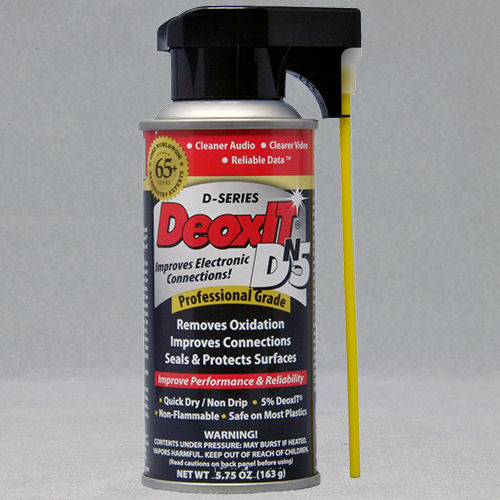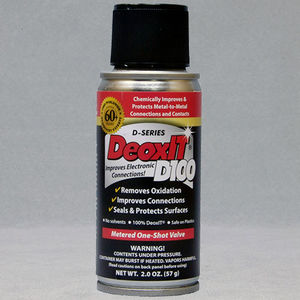
Lubricant spray DeoxIT®protectivefor metalfor plastics


Add to favorites
Compare this product
Characteristics
- Function
- lubricant, protective
- Applications
- for metal, for plastics
- Other characteristics
- non-flammable, solvent, quick evaporating
- Size
133 ml
(4.5 US fl oz)
Description
Applicator: Non-Flammable Spray, provides precise control and application of DeoxIT®. Quick-Dry, Non-Drip Solvent.
Formulation: 5% DeoxIT® (active ingredient), 75% Solstice PF (carrier solvent), 20% propellant
Use: Solvent evaporates quickly, providing precise control, no dripping and overspray. Is ideal for applying on delicate connectors and components on and in equipment.
Notes: Use when over spray is an issue. Formulation safe on plastics. Always recommend testing for compatibility, especially on critical/sensitive parts, and vintage equipment with aging ABS plastic(s). Will not swell rubber. For more flushing action and non-critical applications, we recommend Part Nos. D5S-6, D5S-6ET.
INFO: Using DeoxIT® Sprays, Cautions, Warnings and Best Practices (caig.com/d-sprays).
More than a Contact Cleaner . . . Improves & Protects Connections!
DeoxIT® D-Series contact treatment is a fast-acting deoxidizing solution that rejuvenates, lubricates, protects and improves conductivity on all metal connectors and contacts.
Use as a general treatment for connectors, contacts and other metal surfaces, and on non-critical metal surfaces with severe oxidation and corrosion. If the metal surface is discolored, it is severe. DeoxIT® dissolves the contamination and protects the surface.
For reference, DeoxIT® has approximately 20% deoxidizing action.
KEY FEATURES:
Improves Conductivity
Reduces Intermittent Connections
Reduces Arcing & RFI
Reduces Wear & Abrasion
* Temperature Range, -34 C (-29 F) to +200 C (400 F)
VIDEO
Catalogs
Related Searches
- Protective covering
- Metal aerosol spray
- Protective spray
- Hard cleaning job detergent
- Cleaning cleaning product
- Plastic aerosol
- Lubricant spray
- Wire coating
- Flammable spray
- Metal cleaning product
- Solvent spray
- Water-based cleaning product
- Glass spray
- Duster spray
- Fast-acting spray
- Silicone spray
- Couplant
- Quick evaporating spray
- Glass cleaning product
- Plastic detergent
*Prices are pre-tax. They exclude delivery charges and customs duties and do not include additional charges for installation or activation options. Prices are indicative only and may vary by country, with changes to the cost of raw materials and exchange rates.









